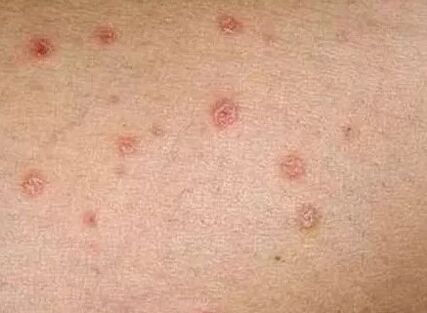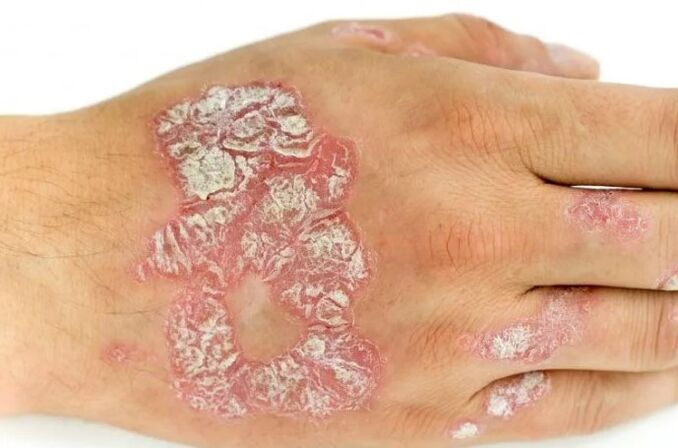Although the cause of psoriasis is unknown and its causes, the stage of its development has been fully studied.The classification of psoriasis in stages helps to assess the progression of the disease, helps determine sensitivity to a certain treatment and determines the patient's strategies.

The stages of psoriasis are classified according to the nature of the aggravation (or the inflammatory process) and the severity.
The stage of psoriasis, depending on the worsening
Psoriasis is a disease with 3 stages:
- progress;
- fixed;
- fall;
- ease.
Symptoms of the gradual stage
The characteristics of this stage are obvious signs.Multiple rashes appear on the skin, in the form of an oval or round red nodule (papules, nodules).They merge and form a focus, occupying a large area, the surface is actively peeling off, and the patient also experiences severe itching of the skin, which sometimes produces a burning feeling.Itching is not only in normal life, but also in dreams, and when it comes to clothes.After the scales lag, the surface can become wet and become a nutrient medium to spread bacteria.
The main manifestations of the progress stage are:
- The appearance of papules on the surface of extensor muscles on the limbs and on the body;
- Papules fuse into conglomerates (“plaques”) with a whitening color;
- Conglomerate surface peeling;
- The area at the edge of the plaque has no scale, but has a margin with a high blood rate.
- The edges of the plaque are compacted;
- The existence of kebner phenomenon: When mechanical damage (cutting, scratching) occurs on uninhabited skin, new psoriatic plaques form.
During the gradual stage, the more intense the redness of the skin, the more active the inflammatory process becomes.The most dangerous result of psoriasis is psoriatic arthritis, while severe joint pain is deformed.

Symptoms of the quiescent phase
As the fixation phase begins, the gradual attenuation of the aggravation process occurs.Meanwhile, the papules turn white, and they turn from red to pink, during which time no new rashes appear.The surface of the knot has the form of a "plaque", which is dense, covered with the earth's crust, and is represented by many dry skin scales.The healing nature of papules begins from the center to the periphery.The presence of the fixation stage of psoriasis confirms the effectiveness of the treatment.
The main manifestations of this stage are:
- rash lacking new papules;
- The existing plaque stopped its growth;
- The surface of the patch is covered with scales.
- The red edge disappears around the flaky patches.
- Kebner's phenomenon disappeared.
Symptoms of the return phase
In the regression phase, the process is participation."Placuline" is solved, forming areas where skin falls off.The itching of the skin gradually disappears and signs of lower peeling.
Signs of psoriasis regression:
- There is a vonov around the plaque (a visible fold of the dense ring surrounding the psoriatic plaque);
- The reduction and gradual disappearance of peeling;
- In the location of the plaque, a dislocation area (white or dark) is formed.
During the regression phase, the plaques completely disappear, and there may be traces of plaques in this area: knees, elbows, abdomen, hips.
ease
Remission is the stage of obvious recovery.During the relief process, psoriasis is in a state of "sleep" but does not disappear from the body.Remission of psoriasis continues until the next aggravation (progressive stage).

It should be noted that during the aggravation of psoriasis, a person's overall situation will not change, he goes to work and is engaged in familiar family affairs.Psoriasis only brings aesthetic and beauty defects to a person: the patient has many scratches on the skin, and a person cannot wear open clothes. If the condition is observed in the summer, a person cannot visit the swimming pool, go to massage, cosmetics, cosmetic procedures, etc.
The stage of psoriasis, depending on the area of the lesion
The severity of psoriasis also depends on the area of the skin lesions.Therefore, at a mild stage, only 3% of the skin surface is affected, averaged from 3% to 10%, while one weight is more than 10%.Psoriasis causes joint damage, which is of the severity. In this case, the area of skin lesions is not considered.You can measure the damage area yourself.To do this, the rule of using open palms (the area of the skin corresponds to the area of the human palms to 1% of the entire body surface).
PASI index
The general system for assessing psoriasis severity is assessed using the PASI index, which includes assessing prevalence and severity, as well as the severity of disease manifestations.This metric is estimated to be 0 to 72.Meanwhile, the index of mild psoriasis is less than 10, with an average of 10 to 20 and a weight exceeding 20.Using the PASI index, the clinical effectiveness of the treatment was also calculated.
In addition to different stages, psoriasis also has different types: fat, exudate, soles, interstitial, old, rupee, psoriasis of nails and mucous membranes.A complete cure for psoriasis is impossible, but you can relieve it for a long time.It is this goal that is pursued through modern therapeutic approaches.























